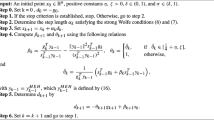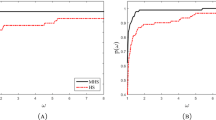Abstract
An improved version of derivative-free nonlinear least squares iterative solver developed earlier by the author is described. First, we apply a regularization technique to stabilize the evaluation of search directions similar to the one used in the Levenberg-Marquardt methods. Second, we propose several modified designs for the rectangular preconditioning matrix, in particular a sparse adaptive techniques avoiding the use of pseudorandom sequences. The resulting algorithm is based on easily parallelizable computational kernels such as dense matrix factorizations and elementary vector operations thus having a potential for an efficient implementation on modern high-performance computers. Numerical results are presented for several standard test problems as well as for some special complex-valued cases to demonstrate the effectiveness of the proposed improvements to method.
Access this chapter
Tax calculation will be finalised at checkout
Purchases are for personal use only
Similar content being viewed by others
References
Armijo, L.: Minimization of functions having Lipschitz continuous first partial derivatives. Pac. J. Math. 16(1), 1–3 (1966)
Averick, B.M., Carter, R.G., Xue, G.L., More, J.J.: The MINPACK-2 test problem collection (No. ANL/MCS-TM-150-Rev.) Argonne National Lab., IL (United States) (1992)
Brown, P.N.: A local convergence theory for combined inexact-Newton/finite-difference projection methods. SIAM J. Numer. Anal. 24(2), 407–434 (1987)
Brown, P.N., Saad, Y.: Hybrid Krylov methods for nonlinear systems of equations. SIAM J. Sci. Stat. Comput. 11(3), 450–481 (1990)
Brown, P.N., Saad, Y.: Convergence theory of nonlinear Newton-Krylov algorithms. SIAM J. Optim. 4(2), 297–330 (1994)
Kaporin, I.E.: Esimating global convergence of inexact Newton methods via limiting stepsize along normalized direction, report 9329. Department of Mathematics, Catholic University of Nijmegen, Nijmegen, The Netherlands, p. 8 (1993)
Kaporin, I.E.: The use of preconditioned Krylov subspaces in conjugate gradient type methods for the solution of nonlinear least square problems (Russian). Vestnik Mosk. Univ. Ser. (Computational Math. Cybernetics) 15(3), 26–31 (1995)
Kaporin, I.E., Axelsson, O.: On a class of nonlinear equation solvers based on the residual norm reduction over a sequence of affine subspaces. SIAM J. Sci. Comput. 16(1), 228–249 (1994)
Kaporin, I.: Preconditioned subspace descent method for nonlinear systems of equations. Open Comput. Sci. 10(1), 71–81 (2020)
Kaporin, I.: A derivative-free nonlinear least squares solver. In: Olenev, N.N., Evtushenko, Y.G., Jaćimović, M., Khachay, M., Malkova, V. (eds.) OPTIMA 2021. LNCS, vol. 13078, pp. 217–230. Springer, Cham (2021). https://doi.org/10.1007/978-3-030-91059-4_16
Kazeev, V.A., Tyrtyshnikov, E.E.: Structure of the Hessian matrix and an economical implementation of Newton’s method in the problem of canonical approximation of tensors. Comput. Math. Math. Phys. 50(6), 927–945 (2010). https://doi.org/10.1134/S0965542510060011
More, J.J., Garbow, B.S., Hillstrom, K.E.: Testing unconstrained optimization software. Argonne National Laboratory, Applied Mathematics Division, Technical Memorandum No. 324, p. 96 (1978)
Northby, J.A.: Structure and binding of Lennard-Jones clusters: \(13\le N\le 147\). J. Chem. Phys. 87(10), 6166–6177 (1987)
Oseledets, I.V., Savostyanov, D.V.: Minimization methods for approximating tensors and their comparison. Comput. Math. Math. Phys. 46(10), 1641–1650 (2006). https://doi.org/10.1134/S0965542506100022
Pan, V.Y., Qian, G.: Randomized preprocessing of homogeneous linear systems of equations. Linear Algebra Appl. 432, 3272–3318 (2010)
Sterck, H.D., Miller, K.: An adaptive algebraic multigrid algorithm for low-rank canonical tensor decomposition. SIAM J. Sci. Comput. 35(1), B1–B24 (2013)
Toint, P.L.: Some numerical results using a sparse matrix updating formula in unconstrained optimization. Math. Comput. 32(143), 839–851 (1978)
Wales, D.J., Doye, J.P.K.: Global optimization by basin-hopping and the lowest energy structures of Lennard-Jones clusters containing up to 110 atoms. J. Phys. Chem. A 101(28), 5111–5116 (1997)
Yu, L., Barbot, J.P., Zheng, G., Sun, H.: Compressive sensing with chaotic sequence. IEEE Sig. Process. Lett. 17(8), 731–734 (2010)
Acknowledgement
The author thanks the anonymous referee for insightful comments and suggestions which allow to significantly improve the exposition of the paper.
Author information
Authors and Affiliations
Corresponding author
Editor information
Editors and Affiliations
A Limiting Stepsize Along Subnormalized Direction
A Limiting Stepsize Along Subnormalized Direction
Similar to [6, 9], the proof of (9) is based on the assumption that the limiting stepsize \(\widehat{\alpha }=\widehat{\alpha }(f,p)\) along a subnormalized direction p exists such that the limiting stepsize condition
is satisfied for all \(0<\alpha \le \widehat{\alpha }\). (To clarify the notations, further we will omit the iteration index t.) For instance, a sufficient condition for (26) to hold is that f satisfies the local Lipschitz condition at x and J(x) has full column rank, see, e.g., [9]. Indeed, (9) can be obtained from (26) and (8) as follows:
where the latter estimate follows from the inequality
which holds for any \(0\le \eta \le 1\) and is used with \(\eta =\alpha (2-\alpha )\Vert Jp\Vert ^2/\Vert f\Vert ^2\), see also (11).
Rights and permissions
Copyright information
© 2022 The Author(s), under exclusive license to Springer Nature Switzerland AG
About this paper
Cite this paper
Kaporin, I. (2022). A Derivative-Free Nonlinear Least Squares Solver. In: Olenev, N., Evtushenko, Y., Jaćimović, M., Khachay, M., Malkova, V., Pospelov, I. (eds) Advances in Optimization and Applications. OPTIMA 2022. Communications in Computer and Information Science, vol 1739. Springer, Cham. https://doi.org/10.1007/978-3-031-22990-9_1
Download citation
DOI: https://doi.org/10.1007/978-3-031-22990-9_1
Published:
Publisher Name: Springer, Cham
Print ISBN: 978-3-031-22989-3
Online ISBN: 978-3-031-22990-9
eBook Packages: Computer ScienceComputer Science (R0)




